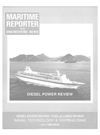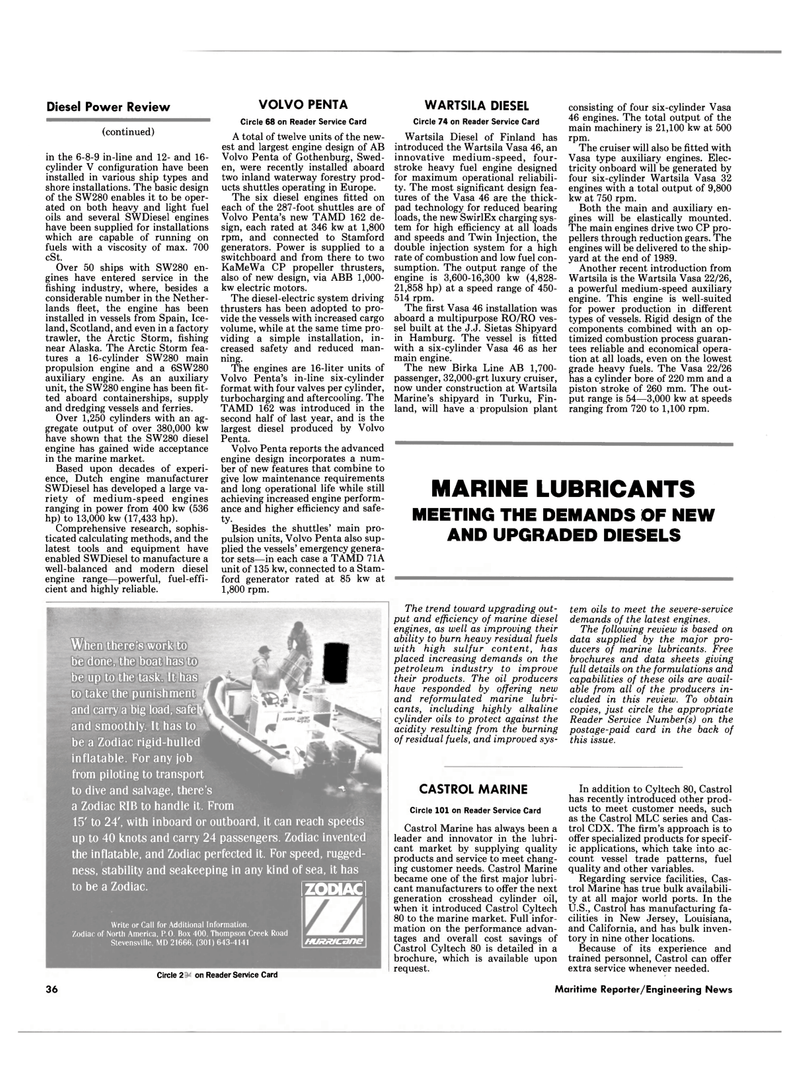
Page 34: of Maritime Reporter Magazine (July 1989)
Read this page in Pdf, Flash or Html5 edition of July 1989 Maritime Reporter Magazine
Diesel Power Review (continued) in the 6-8-9 in-line and 12- and 16- cylinder V configuration have been installed in various ship types and shore installations. The basic design of the SW280 enables it to be oper- ated on both heavy and light fuel oils and several SWDiesel engines have been supplied for installations which are capable of running on fuels with a viscosity of max. 700 cSt.
Over 50 ships with SW280 en- gines have entered service in the fishing industry, where, besides a considerable number in the Nether- lands fleet, the engine has been installed in vessels from Spain, Ice- land, Scotland, and even in a factory trawler, the Arctic Storm, fishing near Alaska. The Arctic Storm fea- tures a 16-cylinder SW280 main propulsion engine and a 6SW280 auxiliary engine. As an auxiliary unit, the SW280 engine has been fit- ted aboard containerships, supply and dredging vessels and ferries.
Over 1,250 cylinders with an ag- gregate output of over 380,000 kw have shown that the SW280 diesel engine has gained wide acceptance in the marine market.
Based upon decades of experi- ence, Dutch engine manufacturer
SWDiesel has developed a large va- riety of medium-speed engines ranging in power from 400 kw (536 hp) to 13,000 kw (17,433 hp).
Comprehensive research, sophis- ticated calculating methods, and the latest tools and equipment have enabled SWDiesel to manufacture a well-balanced and modern diesel engine range—powerful, fuel-effi- cient and highly reliable.
VOLVO PENTA
Circle 68 on Reader Service Card
A total of twelve units of the new- est and largest engine design of AB
Volvo Penta of Gothenburg, Swed- en, were recently installed aboard two inland waterway forestry prod- ucts shuttles operating in Europe.
The six diesel engines fitted on each of the 287-foot shuttles are of
Volvo Penta's new TAMD 162 de- sign, each rated at 346 kw at 1,800 rpm, and connected to Stamford generators. Power is supplied to a switchboard and from there to two
KaMeWa CP propeller thrusters, also of new design, via ABB 1,000- kw electric motors.
The diesel-electric system driving thrusters has been adopted to pro- vide the vessels with increased cargo volume, while at the same time pro- viding a simple installation, in- creased safety and reduced man- ning.
The engines are 16-liter units of
Volvo Penta's in-line six-cylinder format with four valves per cylinder, turbocharging and aftercooling. The
TAMD 162 was introduced in the second half of last year, and is the largest diesel produced by Volvo
Penta.
Volvo Penta reports the advanced engine design incorporates a num- ber of new features that combine to give low maintenance requirements and long operational life while still achieving increased engine perform- ance and higher efficiency and safe- ty.
Besides the shuttles' main pro- pulsion units, Volvo Penta also sup- plied the vessels' emergency genera- tor sets—in each case a TAMD 71A unit of 135 kw, connected to a Stam- ford generator rated at 85 kw at 1,800 rpm.
I When there's work to be done, the boat has to be up to the task. It has to take the punishment and carry a big load, safe and smoothly. It has to be a Zodiac rigid-hulled inflatable. For any job from piloting to transport to dive and salvage, there's 7 a Zodiac RIB to handle it. From 15' to 24', with inboard or outboard, it can reach speeds up to 40 knots and carry 24 passengers. Zodiac invented the inflatable, and Zodiac perfected it. For speed, rugged- ness, stability and seakeeping in any kind of sea, it has to be a Zodiac. [ZODIAC]
Write or Call for Additional Information.
Zodiac of North America, P.O. Box 400, Thompson Creek Road
Stevensville, MD 21666, (301) 643-4141
Circle 328 on Reader Service Card
Huax/cane
WARTSILA DIESEL
Circle 74 on Reader Service Card
Wartsila Diesel of Finland has introduced the Wartsila Vasa 46, an innovative medium-speed, four- stroke heavy fuel engine designed for maximum operational reliabili- ty. The most significant design fea- tures of the Vasa 46 are the thick- pad technology for reduced bearing loads, the new SwirlEx charging sys- tem for high efficiency at all loads and speeds and Twin Injection, the double injection system for a high rate of combustion and low fuel con- sumption. The output range of the engine is 3,600-16,300 kw (4,828- 21,858 hp) at a speed range of 450- 514 rpm.
The first Vasa 46 installation was aboard a multipurpose RO/RO ves- sel built at the J.J. Sietas Shipyard in Hamburg. The vessel is fitted with a six-cylinder Vasa 46 as her main engine.
The new Birka Line AB 1,700- passenger, 32,000-grt luxury cruiser, now under construction at Wartsila
Marine's shipyard in Turku, Fin- land, will have a propulsion plant consisting of four six-cylinder Vasa 46 engines. The total output of the main machinery is 21,100 kw at 500 rpm.
The cruiser will also be fitted with
Vasa type auxiliary engines. Elec- tricity onboard will be generated by four six-cylinder Wartsila Vasa 32 engines with a total output of 9,800 kw at 750 rpm.
Both the main and auxiliary en- gines will be elastically mounted.
The main engines drive two CP pro- pellers through reduction gears. The engines will be delivered to the ship- yard at the end of 1989.
Another recent introduction from
Wartsila is the Wartsila Vasa 22/26, a powerful medium-speed auxiliary engine. This engine is well-suited for power production in different types of vessels. Rigid design of the components combined with an op- timized combustion process guaran- tees reliable and economical opera- tion at all loads, even on the lowest grade heavy fuels. The Vasa 22/26 has a cylinder bore of 220 mm and a piston stroke of 260 mm. The out- put range is 54—3,000 kw at speeds ranging from 720 to 1,100 rpm.
MARINE LUBRICANTS
MEETING THE DEMANDS OF NEW
AND UPGRADED DIESELS
The trend toward upgrading out- put and efficiency of marine diesel engines, as well as improving their ability to burn heavy residual fuels with high sulfur content, has placed increasing demands on the petroleum industry to improve their products. The oil producers have responded by offering new and reformulated marine lubri- cants, including highly alkaline cylinder oils to protect against the acidity resulting from the burning of residual fuels, and improved sys- tem oils to meet the severe-service demands of the latest engines.
The following review is based on data supplied by the major pro- ducers of marine lubricants. Free brochures and data sheets giving full details on the formulations and capabilities of these oils are avail- able from all of the producers in- cluded in this review. To obtain copies, just circle the appropriate
Reader Service Number(s) on the postage-paid card in the back of this issue.
CASTROL MARINE
Circle 101 on Reader Service Card
Castrol Marine has always been a leader and innovator in the lubri- cant market by supplying quality products and service to meet chang- ing customer needs. Castrol Marine became one of the first major lubri- cant manufacturers to offer the next generation crosshead cylinder oil, when it introduced Castrol Cyltech 80 to the marine market. Full infor- mation on the performance advan- tages and overall cost savings of
Castrol Cyltech 80 is detailed in a brochure, which is available upon request.
In addition to Cyltech 80, Castrol has recently introduced other prod- ucts to meet customer needs, such as the Castrol MLC series and Cas- trol CDX. The firm's approach is to offer specialized products for specif- ic applications, which take into ac- count vessel trade patterns, fuel quality and other variables.
Regarding service facilities, Cas- trol Marine has true bulk availabili- ty at all major world ports. In the
U.S., Castrol has manufacturing fa- cilities in New Jersey, Louisiana, and California, and has bulk inven- tory in nine other locations.
Because of its experience and trained personnel, Castrol can offer extra service whenever needed. 36 Maritime Reporter/Engineering News

 33
33

 35
35
